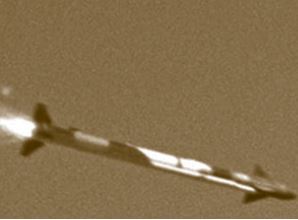Historical Overview
Heat-seeking missiles, also known as air-to-air guided missiles, have been a part of the United States Air Force's (USAF) arsenal for nearly 70 years. The USAF first introduced heat-seeking technology in the 1950s, with the acquisition of the Falcon (AIM-4) and Sidewinder (AIM-9) missiles, and by the outbreak of the Vietnam War, heat-seeking missiles had become a staple of aerial combat [1]. Since nearly the invention of heat-seeking missile technology, engineers have been simultaneously developing countermeasures to trick the sensor into missing its target. At first, these countermeasures were relatively crude in design, consisting of flares that the pilot could deploy when under attack. As the technology evolved, flares were starting to be phased out, and "heat-seeking missile countermeasures based on hot sources" began to be phased in [2]. These early devices were essentially larger versions of the Globar used in modern infrared (IR) spectrometers. These hot sources consisted of a mass of silicon carbide, which, when current passes through, heats up to the point where it emits large quantities of IR radiation from roughly 4 microns to 15 microns in wavelength. Coupled with a rotating, mechanical shutter that would modulate the thermal output, these sources make it impossible for the heat-seeking missile to lock on to the target [2].
Unlike flares, which can only be deployed once and required the pilot to deploy them once targeted actively, these so-called "hot sources" could remain active during the entire mission, significantly improving the effectiveness of the countermeasure. As laser technology improved, it eventually became viable to replace the Globar with an IR laser source, reducing the weight and complexity of the system. In 1997, D. B. Meeker, working for the United States Navy, patented one of the earliest known aerial laser IR countermeasures, designed for use onboard an aircraft [3].
It is by no coincidence that this patent application coincides with the invention of the Quantum Cascade Laser (QCL) at Bell Labs in the mid-1990s, which is now capable of producing light anywhere between 4 microns and 12 microns. Now that it has been close to a quarter-century since the invention of the QCL, they are the source of choice for modern IR countermeasure systems. This article will go on to explain why the mid-IR spectral region is so vital for heat-seeking missiles, and it will further elaborate on the importance of QCLs with examples of modern commercially available devices.
Quantum Cascade Lasers
While, technically, QCLs are a subset of semiconductor lasers, in practice, they are fundamentally different enough to warrant their unique classification. Unlike classical semiconductor lasers which rely on single electron-hole recombination to generate photons, QCLs utilize a large number of thin active sections, which, when combined, create a series of stepwise electric potentials across the device, with a sloping potential gradient, which in turn results in the electron having to cascade down through the potential wells releasing a photon at each step. Figure 1 below illustrates the differences between the band structure of traditional
laser diodes and QCLs.
[caption id="attachment_46198" align="alignright" width="442"]

Figure 1: Comparison of the bandgap conventional diode structure lasers (left) and QCLs (left). Courtesy of mirSense based in Orsay, France.[/caption]
As a result, the wavelength is not limited by the intrinsic energy gap of the material and can produce wavelengths in the mid-IR range. Furthermore, the cascade effect creates an enhancement factor that allows for QCLs to provide several orders of magnitude more power at a given wavelength than traditional semiconductor lasers. For a more detailed review of QCL technology, the reader is encouraged to read "An Overview on Quantum Cascade Lasers: Origins and Development," by Raúl Pecharromán-Gallego [4].
Detection Wavelength
The basic functionality of a heat-seeking missile is quite similar to that of a night vision imaging system; in that it uses an IR imaging device, such as an InSb focal plane array, to lock on to the aircraft by tracking its blackbody emissions. The main difference between these two technologies is the wavelength range over which they operate; most of the objects on earth have a temperature ranging from 275 K to 300 K, which correlates to a peak black body emission wavelength of roughly 10 microns. By contrast, a typical turbojet engine has an exhaust gas temperature ranging from 1200 K to 1900 K [1], corresponding to a peak black body emission wavelength ranging from 2.4 microns to 1.5 microns. Unfortunately, in this spectra region, there is too great of overlap with the sun's emission spectrum to get a clea
To continue please fill out the form below

 Figure 1: Comparison of the bandgap conventional diode structure lasers (left) and QCLs (left). Courtesy of mirSense based in Orsay, France.[/caption]
As a result, the wavelength is not limited by the intrinsic energy gap of the material and can produce wavelengths in the mid-IR range. Furthermore, the cascade effect creates an enhancement factor that allows for QCLs to provide several orders of magnitude more power at a given wavelength than traditional semiconductor lasers. For a more detailed review of QCL technology, the reader is encouraged to read "An Overview on Quantum Cascade Lasers: Origins and Development," by Raúl Pecharromán-Gallego [4].
Figure 1: Comparison of the bandgap conventional diode structure lasers (left) and QCLs (left). Courtesy of mirSense based in Orsay, France.[/caption]
As a result, the wavelength is not limited by the intrinsic energy gap of the material and can produce wavelengths in the mid-IR range. Furthermore, the cascade effect creates an enhancement factor that allows for QCLs to provide several orders of magnitude more power at a given wavelength than traditional semiconductor lasers. For a more detailed review of QCL technology, the reader is encouraged to read "An Overview on Quantum Cascade Lasers: Origins and Development," by Raúl Pecharromán-Gallego [4].

 SHIPS TODAY
SHIPS TODAY 